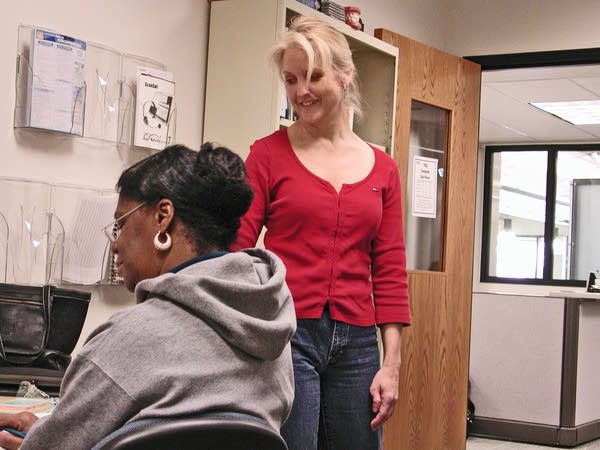Popular PSEO program is free for students, pricey for school districts
Go Deeper.
Create an account or log in to save stories.
Like this?
Thanks for liking this story! We have added it to a list of your favorite stories.

Adam Gardner is in his first semester at Dakota County Technical College in Rosemount. He's a soft-spoken senior at Cannon Falls High School, south of the Twin Cities.
Gardner's Detroit Tigers baseball cap is fashionably cocked off to one side. The words "skate or die" line his t-shirt. He's easily the youngest person in Gayle Larson's 11 a.m. writing and research class, but in no way does he stand out in the mix of recent high school graduates and older returning students.

"It's actually more laid back than I thought it would be," Gardner said. "Better than high school was. There are a lot more people here. Everybody talks to everybody. It's more open. There's no clicky kind of things going."
His mother, Laura Gardner, said Adam has already embraced his new environment and has a renewed focus to study business at a four-year university next fall.
Turn Up Your Support
MPR News helps you turn down the noise and build shared understanding. Turn up your support for this public resource and keep trusted journalism accessible to all.
"He's already, in his first week, made friends," Laura Gardner said. "He's finding out you don't just have to sit in class. You have more choices, more consequences, more responsibilities. I think it will be great for him to learn how to step up and take control of his own life, which is one thing he didn't like about high school -- being told what to do."
And for the 15 credits Adam will end up with, he saves his family more than $2,000 toward the cost of his college education.
But that money has to come from somewhere.
"(There) are actually too many students for one teacher and not enough for two. And this creates problems for us."
Adam is one of 11 students at Cannon Falls High School taking PSEO courses full time this year. That's about 10 percent of the senior class.
When those students leave the building, state money -- between $5,000 and $6,000 per student -- goes with them.
It's a reality Superintendent Todd Sesker said his district has learned to live with. He said Cannon Falls has to compete by offering Advanced Placement courses, and providing something else the college campuses can't.
"Some students are ready to go to college and ready to get out and work in the real world," Sesker said. "They're tired of high school and they want to try something different. And other kids aren't. They like the community and the social atmosphere that a high school offers."
The budget crunch for Cannon Falls gets worse because the district sees its enrollment drop about 20 students a year.
The PSEO balancing act gets tougher the smaller the school.
In northern Minnesota, the Ely School District is reeling from a series of financial setbacks. In addition, 12 high school students are going full time, and four are part time, at nearby Vermillion Community College this year.
School Board Chairman Ray Marsnik, himself a graduate of Ely Memorial High School, said each student is crucial to the future of the district, now more than ever.

"We're getting classes that are basically right around 40, which are actually too many students for one teacher and not enough for two. And this creates problems for us," Marsnik said.
Ely doesn't have enough students or teachers to offer Advanced Placement courses like some larger districts do, in order to compete for the PSEO students and the state education money that goes with them.
When the PSEO program started statewide in the mid-'80s, about 3,500 students took PSEO courses. That number has now leveled off at about 7,500. That's about 5.5 percent of the state's 11th and 12th graders.
State Education Commissioner Alice Seagren said PSEO has valuable financial and educational benefits for students.
"I think we need to look at this much more holistic, and look at a seamless system and a transition period and points where kids can ... kind of come back and forth between the two systems," Seagren said. "Bottom line, how can we help our kids and support them?"
The state Legislature changed the PSEO funding formula in the early 1990s to help school districts. They now get a small part, 12 percent, of the state money they normally would have gotten for each student before PSEO.
School administrators and state officials don't expect the Legislature to increase that any time in the future.
Dear reader,
Political debates with family or friends can get heated. But what if there was a way to handle them better?
You can learn how to have civil political conversations with our new e-book!
Download our free e-book, Talking Sense: Have Hard Political Conversations, Better, and learn how to talk without the tension.





